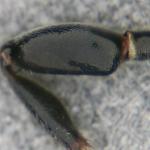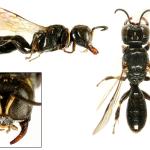Crossocerus affinis LEPELETIER & BRULLÉ,1835; Crossocerus annulatus LEPELETIER & BRULLÉ,1835; Crossocerus luteipalpis LEPELETIER & BRULLÉ,1835; Crossocerus morio LEPELETIER & BRULLÉ,1835; Crossocerus pallidipalpis LEPELETIER & BRULLÉ,1835; Crossocerus varipes LEPELETIER & BRULLÉ,1835; Crabro hyalinus (SHUCKARD,1837); Crabro obliquus (SHUCKARD,1837); Crabro propinquus (SHUCKARD,1837); Crabro proximus (SHUCKARD,1837); Crabro transversalis (SHUCKARD,1837); Crabro brevis (EVERSMANN,1849); Crabro scutellaris (SMITH,1851); Crabro sulcus (SMITH,1851); Stenocrabro plesius (ROHWER,1912); Crabro berlandi (RICHARDS,1928)
A rather variable species across its range, being given various infraspecific names; the British form has been referred to as subspecies proximus (Shuckard) (Richards 1980) or propinquus (Shuckard) (Lomholdt 1975-76).
England, Wales and Scotland (north to Inverness-shire). Channel Islands. Abroad, the species is found widely in Europe, east to the Urals, Caucasus and Kazakhstan, and south to north Africa (Lomholdt 1975-76). Lomholdt also gave North America, regarding C. sulcus (Fox) as a synonym, but Bohart & Menke (1976) considered this to be a separate species. The true C. elongatulus has been introduced to Argentina.
This species is not regarded as being scarce or threatened.
Found in a variety of open habitats including scrub and woodland edges (M Edwards, pers. comm.).
Probably bi- or multivoltine: found from May (in the south) or June (north) to September.
The prey consists of small flies, e.g. Chloropidae, Lauxaniidae, Stratiomyidae, Empididae, Dolichopodidae, Agromyzidae (Lomholdt 1975-76). Nesting biology The female usually nests in the ground, such as sandy banks. However, the species has been found in the soft mortar of brickwork and stone walls, and even in dead wood, e.g. posts containing beetle exit holes. Several females may share one burrow (Lomholdt 1975-76). No data can be found on the number of prey per cell or other details of nesting biology. Males shelter from inclement weather in holes in posts (pers. obs.).
No information available although the species has been found visiting honeydew on leaves (pers. obs.).
The miltogrammine fly, Macronychia polyodon (Diptera: Sarcophagidae), has been found to be a cleptoparasite (Lomholdt 1975-76).
2005



